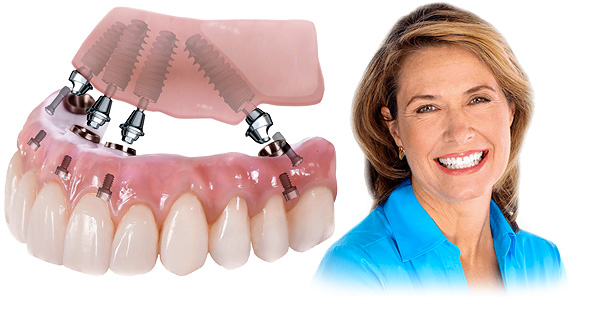
Bone atrophy is the number one problem that becomes an obstacle to dental implantation. But with one caveat - according to the classical method, since today a number of dentists offer patients methods of prosthetics on implants without building the jaw bone. These are the All-on-4 and All-on-6 protocols.
Literally, their name translates as "all four" and "all six." The methods act as a kind of alternative to removable prosthetics with full adentia or in cases where it is necessary to remove some of the living teeth in poor condition.
All-on-4 technology is a patented development of the American-Swiss company Nobel, which has been producing dental implants of the same name for more than half a century. Prosthetics on six implants is, in fact, the next generation, since the development of this technique took into account the disadvantages and shortcomings of the All-in-Four technology.
Both methods are used in the presence of atrophied bone tissue and involve immediate loading of the prosthesis. Only now they are not found in every clinic.
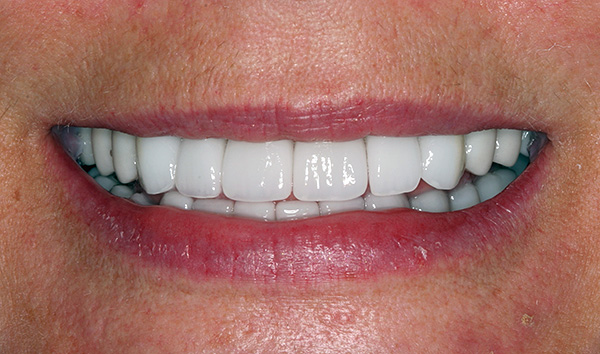
Next, we will try to understand the pros and cons of each method and find out why they are not too common in our country - due to the lack of skills of implantologists, fragility or are there other disadvantages?
What is the essence of All-on-4 technology?
As mentioned earlier, this development belongs to Nobel, which was the first in the world to collaborate with the developer of dental implants (Dr. Branemarck) and launched the products into mass production.
It is interesting
The All-on-4 concept was first put into practice in 1998 by Portuguese implantologist Paulo Malo. At first, the doctor worked separately, but later its development was acquired by Nobel, which in 2004 introduced this treatment concept to the market.
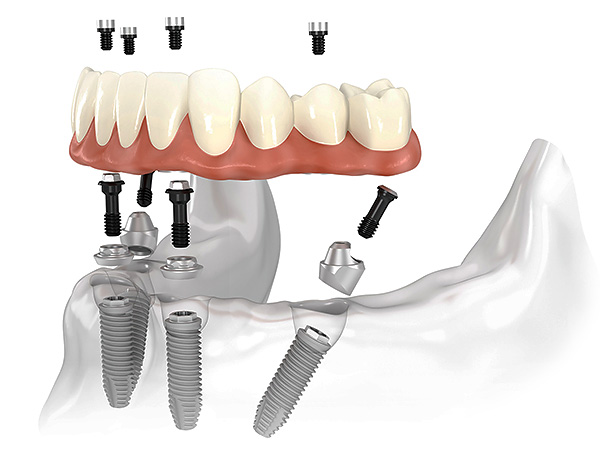
The concept of prosthetics on four implants is more common abroad (in Europe and the USA) than in our country. This is explained by the fact that the implantologist must undergo training and receive a certificate from Nobel for the right to work with this protocol.
It is worth noting that Nobel products are one of the most expensive, and this is one of the reasons why doctors are in no hurry to obtain the appropriate certificates - there will simply be little demand for implants, and implantologists themselves often do not have the opportunity to undergo appropriate, very expensive training.
So, the fundamental differences between All-on-4 tooth prosthetics technology are as follows:
- Only 4 dental implants are used for prosthetics of the complete dentition;
- 2 implants are fixed at an angle in the lateral areas (between the fifth and sixth teeth), 2 others - vertically in place of the front teeth;

- The prosthesis is installed immediately, that is, not in a day, not in an hour, but immediately after implantation;
- Implantation with the implementation of All-on-4 technology is carried out with weak or moderate bone resorption, as well as with a sufficient amount of bone tissue;
- Implants are classic two-part constructions, but a multi-unit abutment (angular) is used, which is intended for use with a particular tilt of the implants. That is, the abutment itself after fastening acquires a strictly vertical position;
- At all stages of treatment, computer 3D modeling is used.
Now we will consider each item in more detail - both in terms of advantages and disadvantages that were identified by implantologists practicing this system.
Types of implants and features of their installation
The All-on-4 dental prosthetics technique uses two-component implants with a screw construction - these are, in fact, classic root-shaped models made of pure titanium and equipped with a special porous TiUnite coating (present on all models of implants of this brand). It is a rough layer of titanium oxide with a high phosphorus content, which significantly accelerates the process of osseointegration, that is, bone and implant fusion.
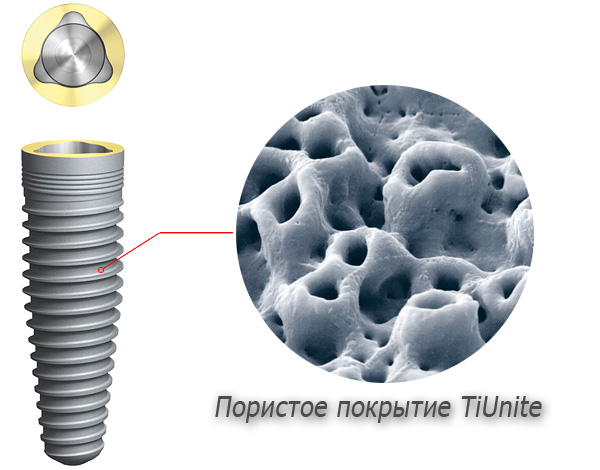
Such implants are also installed in the traditional way (patchwork) - after the introduction of anesthesia, the gum is cut, exfoliated from the bone tissue, a bed under the implant is formed inside the bone (cut out using boron), and after the implant is placed, the gum is sutured.
The concept implies the use of only 4 implants (with the classical approach, they require at least 8-10 per row). Two are attached in the region of the anterior teeth, the other two in the lateral region. And they are fixed at an angle of up to 45º.
Important!
The inclined installation of lateral implants makes it possible to implant them, bypassing important anatomical structures, for example, the jaw nerves, sinuses. In addition, it is possible to more evenly place the implants along the alveolar ridge and optimally distribute the load on them. The inclination of the side “screws” also allows you to increase the contact area between the implant and the bone, which creates a full support for the prosthesis.
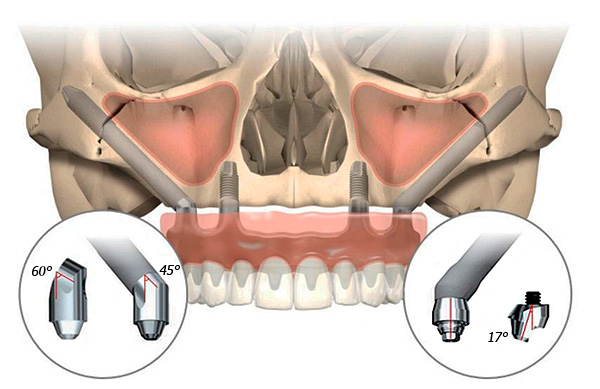
Abutment is fixed on top of the implant. For inclined implants, inclined abutments (multi-unit) are also selected. Due to this, the position of the tips of the implants above the gum is leveled, and the prosthesis is fixed strictly straight, without disturbing the occlusion and occlusion of the patient.
Is it really necessary to build bone when prosthetics using All-on-4 technology?
The All-on-4 concept is used for mild to moderate bone atrophy:
- On the upper jaw - at least 5 mm in width and 10 mm in height;
- On the lower jaw - at least 5 mm in width and 8 mm in height.
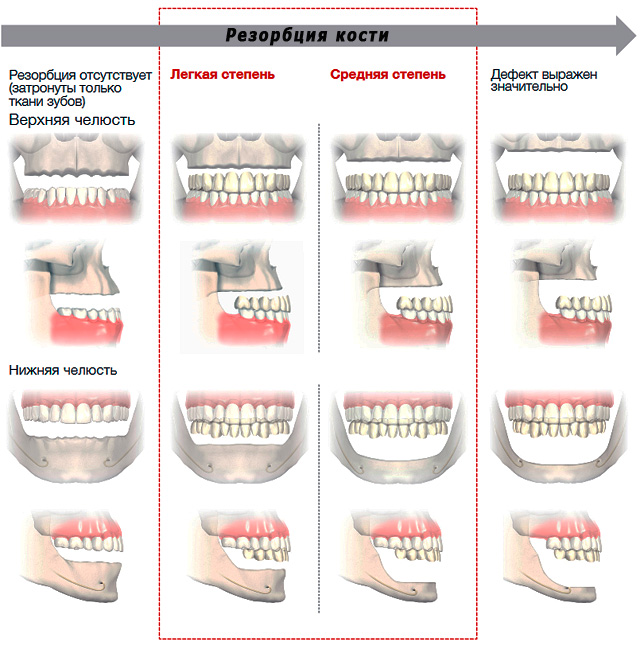
The inclined position of the implants allows you to choose a place with a denser bone of sufficient volume, so the treatment is quite possible with atrophy of bone tissue.
An important feature of the All-on-4 prosthetics method is that its implementation is justified only with a mild atrophy of the jawbone, but not with its pronounced resorption.
The opinion of the practicing dentist:
“All-on-four is undoubtedly one of the best technologies for patients with adentia. But only moderate and mild. The concept suggests that the degree of primary fixation of implants should be at least 35 Newtons, which cannot be achieved in the presence of pronounced bone atrophy. I repeatedly had to observe the work of my colleagues when the lateral implants were shifted slightly forward or backward relative to the place that is recommended to be selected according to the protocol (precisely because of a lack of space). A few years later, this led to a complete collapse of the entire system, since part of the bone simply continued to atrophy due to lack of load. ”
Another point that concerns the state of bone tissue is the implantation simultaneously with the removal of diseased teeth that have been preserved in a row. In the classical approach, it takes a certain amount of time (usually 3-4 months) for the bone tissue to recover, and only then can implantation be performed. With All-on-4 tooth prosthetics technology, the situation is basically the same, only the protocol developer suggests installing implants next to the hole, without waiting for the tissue to completely recover.
Prosthetics options
According to the original All-on-4 protocol, a fixed acrylic bridge is installed immediately, at the same time as the implants are implanted. It is installed for a period of several months (about six months) - that is, you need to wear it until the implants are fused to the bone.
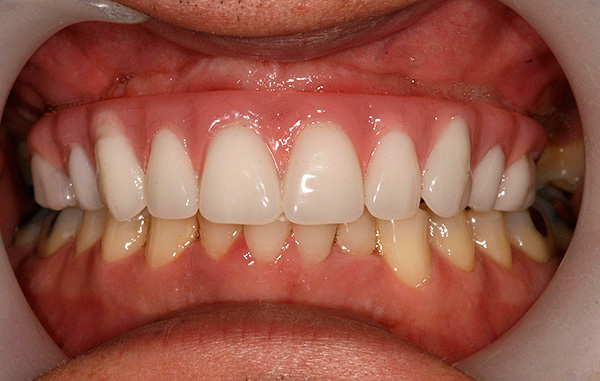
It is also possible to relocate your own removable denture, which the patient previously wore.
Important!
The patient needs to be prepared for the fact that the prosthesis will be made with an acrylic base - a kind of artificial gum. Its use is explained by the fact that you need to "cover up" flaws of your own mucosa, because due to the long absence of teeth it has a very unaesthetic appearance. Performing plastic surgery along the entire row is expensive and difficult in terms of patient rehabilitation. Therefore, such an option is proposed.
The results of prosthetics using All-on-4 technology look quite aesthetically pleasing - examples are shown in the following photos.
Example 1, before treatment:
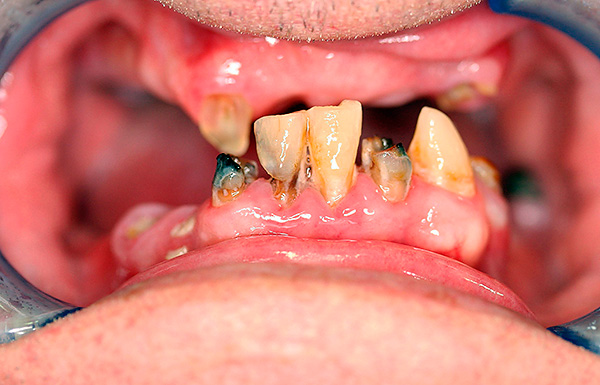
After treatment:
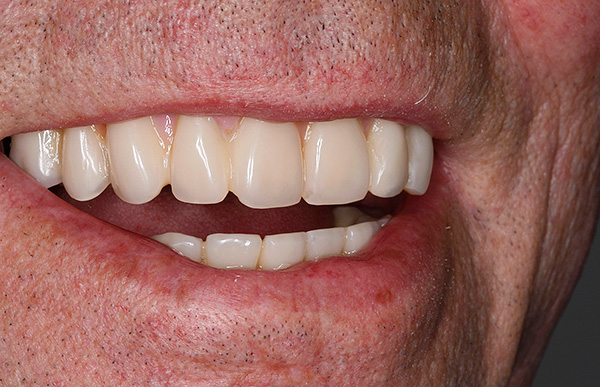
Example 2, photo before treatment:
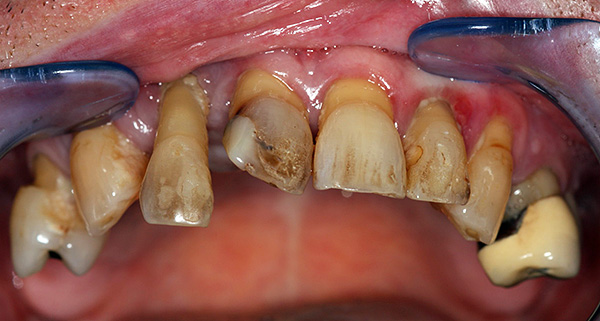
After:
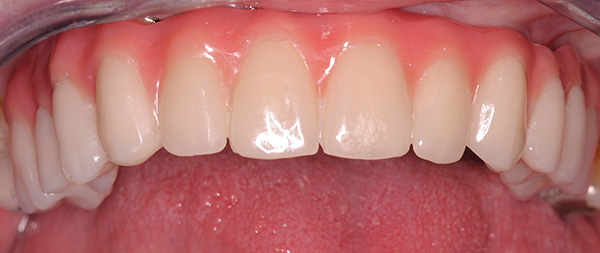
Immediate prosthetics (that is, immediately after implantation) has several goals at the same time:
- All-on-4 prosthesis stabilizes implants. They are interconnected by a metal beam, which ensures their fixation in a certain position. This is possible precisely in the absence of all teeth (if only one implant is loaded, then it will shift under pressure);
- The prosthesis provides a load on the bone. The jawbone of a person must receive pressure - this is physiological, because it is due to it that the cells are nourished. When chewing load is restored inside the bone, natural processes are activated, and regeneration is faster (that is, bone volumes are gradually restored);
- The prosthesis returns the patient aesthetics and the ability to fully eat.
Limitations to the first month after implantation are a gradual increase in the chewing load.
Expert commentary:
“According to the original All-on-4 prosthetics technique, the prosthesis is installed on the same day the implants are implanted. From the point of view of the patient, this is great news, because you leave the doctor’s office with new teeth. But in practice, it is better to move the prosthesis installation for a couple of days and install crowns at least one day after the operation. After all, after installing the implants, sutures are applied and the gums are injured. "It takes some time for their rehabilitation - otherwise pain occurs, and the risk of inflammation of the mucous membranes is also great."
Process simulation
Nobel is renowned for its innovative treatment approach. After the initial consultation with a doctor, a medical or cone beam tomography is performed. The data obtained are downloaded to a computer, and using special software (Nobel Guide), the entire treatment process is simulated in a three-dimensional, three-dimensional version.
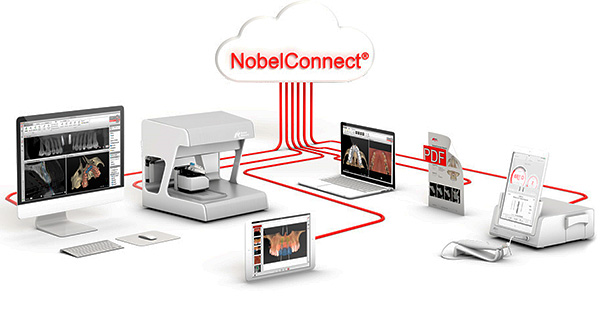
The doctor creates a virtual model of the jaw, sets the volume of the bone, the location of all the important anatomical structures. The program helps to choose a place for implant implantation, and subsequently surgical templates are developed that help to install the “screws” in accordance with the plan, without shifting even by a fraction of a millimeter.
Accurate treatment planning eliminates human error. In addition, the patient himself can evaluate the final result of prosthetics.
As for the cost of treatment ...
But the cost of implanting All-on-4 is one of its main drawbacks. The price of prosthetics is quite high and reaches 400 thousand rubles for the restoration of one dentition.
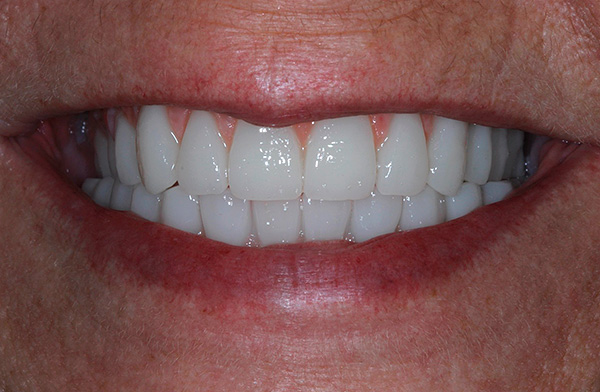
This is explained, firstly, by the high cost of Nobel implants themselves (after all, the company invests a lot of money in research and implementation of unique technologies), and secondly, by the work of the doctors themselves, who need to undergo expensive training. And, thirdly, high-tech equipment that is used in planning and conducting treatment.
Are there any downsides?
If all-in-four implantation is carried out in strict accordance with the original treatment protocol, then it has very few drawbacks.
The first is the high likelihood of inflammation of the mucosa, since the prostheses in the original technique are fixed on the same day as the implants are installed. For the patient, on the one hand, this is a plus, because the aesthetics are restored at the same time. However, in practice, injured gums react with inflammation. The problem is solved by fixing the prosthesis 2-3 days after surgery.
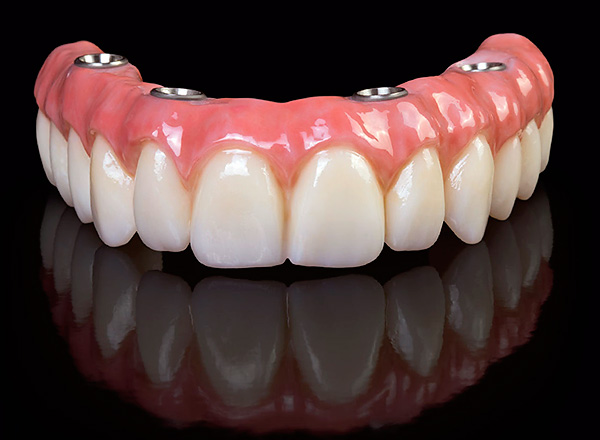
In addition, experts note that for violations of the jawbone volume, four implants are not enough - the bone does not receive the proper load and continues to atrophy, resulting in frequent relocation of the prosthesis and possible displacement of the implants.
Another disadvantage of All-on-4 prosthetics is also associated with bone tissue. To install implants in the bone tissue, a bed is formed using boron. At the same time, part of the cut out own bone is extracted from the hole, and in fact, under conditions of atrophy, the patient’s own bone material is, in essence, “worth its weight in gold”. For comparison: with All-on-6 technology, which will be discussed later, the implants are screwed into the bone by a compression method, and bone loss does not occur - on the contrary, it is compacted around the implant's thread, which contributes to its better fixation.
Can All-on-4 prosthetics be performed on other implants?
The technology of prosthetics "all four" trying to repeat many other companies. But only Nobel has truly clinically proven results in the long run (and it also has a patent for this protocol). Therefore, if you want to undergo treatment using the original technology, then you need to look for doctors who have the appropriate certificates and practical skills in this area.
On the other hand, the use of implants of other brands can significantly reduce the cost of treatment - up to 200 thousand rubles. But to give preference in this case, it is worthwhile to designs that also have proven themselves in the market (for example, Osstem, BioHorizons, Ankylos, Alpha Dent).
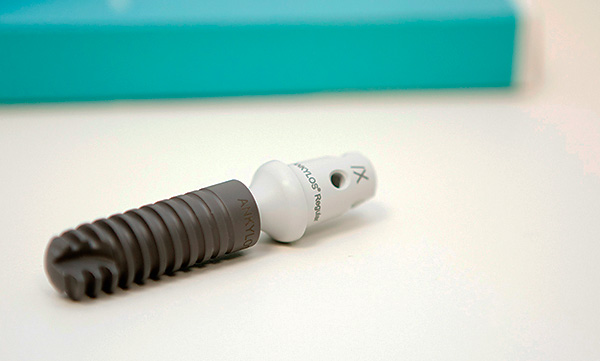
All-on-4 prosthetics patient review:
“I’m 64, I wore removable dentures for a long time, but it bothered me. I am quite an active person, I travel a lot, I love cooking. He turned to several clinics, but the term of treatment per year (!!!) is unacceptable to me. I found the option of prosthetics all on four. Studied carefully. Nobel company inspires confidence. The implants were installed quickly, the bone was implanted simultaneously. The first months there were dietary restrictions, but after half a year I replaced the prostheses with dioxide and enjoy life. The operation was carried out about 3 years ago and to this day my teeth delight me, there are no complaints. ”
Ivan Semenovich, Moscow
About All-on-6 Prosthetics
The All-on-6 prosthetics concept was developed by medical practitioners who took as a basis the practice of using the technology on four implants and took into account the experience of using basal implantation. The protocol is performed using six implants.
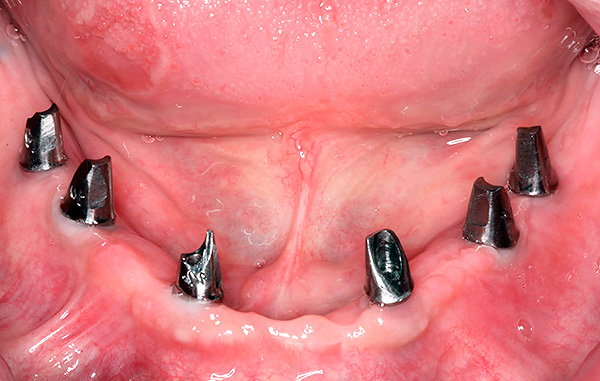
In contrast to All-on-4, indications for treatment were expanded: prosthetics are performed with moderate atrophy of bone tissue, as well as in the presence of periodontitis, periodontal disease or osteomyelitis of the jaw. Smoking is also not a contraindication.
In general, the two technologies are similar - the similarities and differences of the mentioned protocols will be presented below.
To begin with, we outline the distinguishing features of the All-on-6 prosthetics protocol:
- 6 dental implants are used for prosthetics of the complete dentition (4 implants are fixed at an angle in the lateral areas, and 2 others are fixed vertically in the frontal zone);
- The prosthesis is installed 2-3 days after implantation;
- All-on-6 implantation is performed with moderate or severe bone resorption;
- Implants - one-piece with an abutment, the angle of which is selected individually and can be adjusted after implantation of the “screws”;
- The installation of implants is possible simultaneously with the extraction of teeth, and the “screws” are installed in the same hole;
- All-on-6 prosthetics technology is a more cost-effective solution than classical implantation and All-on-4 in the original technique.
Types of implants and features of their installation
When prosthetics using the All-on-6 method, fundamentally different implant models are used than with All-on-4 technology:
- The implants are single-component, that is, the abutment and the intraosseous part are a single whole. After installation, the abutment is tilted to align the bite and the position of the prosthesis;

- The implants are fixed in a minimally invasive way - they are literally screwed into the bone, while the gum does not exfoliate, the sutures after surgery are not overlapped. This means that the patient recovers faster;
- Implants are placed at an angle. As with the all-in-four technology, this approach allows you to bypass the most atrophied parts of the bone, choosing its most durable sections, and also not to hurt the nerves and sinuses.
Does All-on-6 Prosthesis Really Do Not Need to Build Bone?
The designs of the implants used are designed so that their fixation is possible not only in the alveolar (spongy) section of the jawbone, but also in the deeper sections. This is the basal layer, cortical plate or membrane of the bone, as well as the zygomatic bone and buttresses of the jaw (lines of force).
On a note
The most “soft” layer of bone is the central (spongy). 90% of it consists of capillaries. In the absence of teeth, metabolic processes in the bone stop, which means that it is the spongy section that suffers in the first place, significantly reducing in volume. The rest of the departments consist of bone partitions - they are more durable, there are fewer capillaries in them or they are completely absent, and here atrophy is not so pronounced. That is why implants for immediate loading primarily use these layers.
Due to the fact that the implants are fixed in the dense parts of the bone, the strength of their primary stability is 80-100 Newtons, while with classical implantation this indicator varies in the region of 30-40 Newtons.
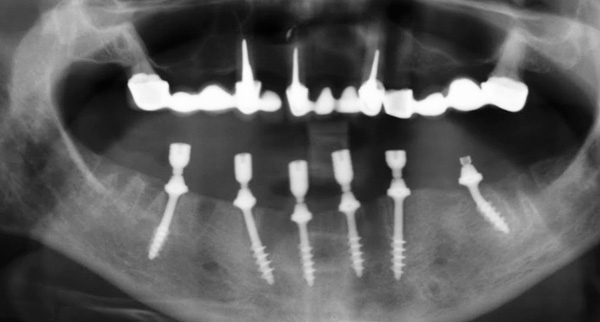
All this suggests that there is no need to build bone during prosthetics with the All-on-6 method - the implants will be fixed in the available volume.
What are the similarities between the two technologies?
The main similarity of the two methods is the possibility of immediate loading of the prosthesis. And the goals of the instant installation of crowns are completely identical - to give a load on the bone, restore the aesthetics and functionality of the dentition and stabilize the implants installed. In both cases, prostheses are created with artificial gums, which will hide the uneven contour of the natural mucosa.
The photo below shows an example of how dentures can look when using both technologies - All-on-4 and All-on-6:
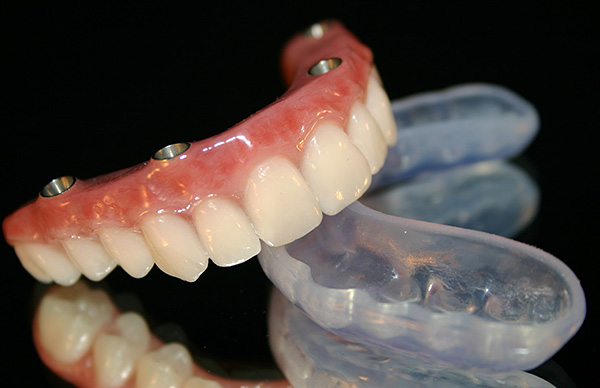
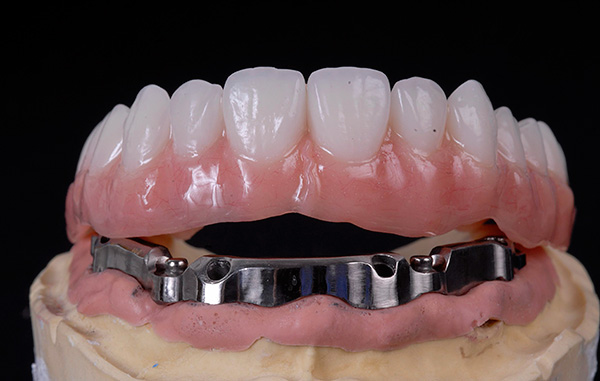
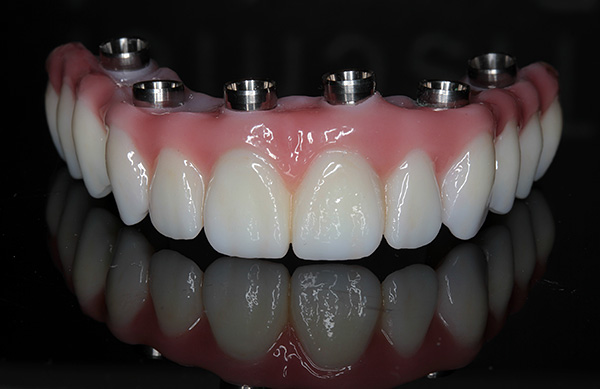
Patient review of prosthetics on six implants:
“I doubted for a long time when choosing this method. It was embarrassing that the prosthesis would have to be changed over time and that it had a plastic gum. After all, it turns out the same removable denture! Doctors showed pictures, but one thing is a photo, and the other is real life. I thought for a long time, but decided, because the price is very attractive. As a result, after installing the implants there was almost no pain, only slight discomfort, as after tooth extraction. The prostheses were placed on day 3, I did not have to get used to them for a long time, since they are much more comfortable than removable ones! While I wear 2.5 years, I periodically go to rebase prostheses. But they look quite worthy, so far I don’t think about changing! ”
Margarita P., Moscow
When planning dental prosthetics according to the All-on-6 method, computer simulation is also used - modern technologies allow the most thorough treatment of the entire treatment process in order to avoid inaccuracies when installing implants.
A few words about prices
All-on-6 prosthetics use implants from brands such as Oneway
Biomed, Osstem, Noris Medical, Bio Horizons - in the product line of these companies there are models specially designed for immediate load. These companies have existed for a long time, which means that there is evidence of successful operations with the results of implant engraftment in the long term.
Companies produce products in the middle price segment, so the cost of treatment is very affordable - from 200 to 300 thousand rubles for a complete prosthesis of one dentition.
What are the disadvantages of All-on-6 technology
The technology of prosthetics All-on-6 appeared later than All-on-4, therefore, during its development the main disadvantages of the protocol were taken into account.
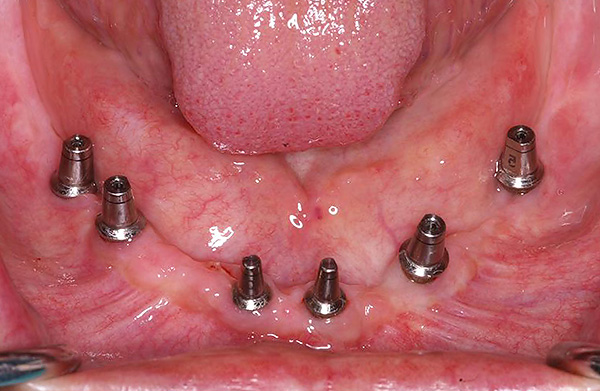
However, there are also disadvantages - prosthetics on six implants belongs to the group of technologies with immediate loading, and a very limited number of implantologists work with them in our country. Firstly, you need to undergo very expensive training abroad, and secondly, you need to be a professional in your field and have knowledge not only of implantology, but also of maxillofacial surgery and orthopedics.
On a note
This method makes great demands on the skill of the attending physician: he must be a maxillofacial surgeon, an orthopedist and have the skill to work with software for 3D-modeling of the treatment process. He must have thorough knowledge of the structure and operation of the jaw system (not only do you need to install implants in a narrow and thin bone, you also need to correctly calculate the load on them and adapt the prosthesis so that it lasts several decades without breakage and is comfortable for the patient )
Specialists working with All-on-6 technology should receive an appropriate certificate that gives permission to work under the immediate load protocol.
If you compare technology, which method is preferable?
To summarize, the similarities and differences between the two technologies are presented in detail in the table below:
| All-on-4 | All-on-6 | Classical dental implantation | |
| Indications | Complete adentia and partial bone loss | Complete adentia and moderate bone loss | The absence of any number of teeth |
| Periodontal inflammatory processes | Not carried out or with restrictions | Unlimited | Not carried out or with restrictions |
| Indications for bone tissue | Sufficient or slight volume loss | Average rate of decline | A sufficient amount (in case of volume violations bone grafting is performed) |
| Smoking | Implantation is not performed or with restrictions | Held | Not carried out or with restrictions |
| The number of implants needed to restore the dentition | 4 things. | 6 pcs | 8-14 pcs. |
| Type of implants | Classic two-piece with inclined multi-unit abutments for screw fastening of the prosthesis | One-part - the implant is connected to an angled abutment for screw fixation of the prosthesis | Classic two-piece with separate abutments |
| Where are the implants attached and how are they installed? | Front - vertically, side - at an angle, a spongy layer is activated | Front - vertically, side - at an angle. All layers of bone tissue are involved, as well as buttresses and zygomatic bone | Strictly upright, in a spongy layer |
| Implant placement injuries | High - tissue incisions are made, the gum exfoliates | Low - implants are puncture mounted | High - tissue incisions are made, the gum exfoliates |
| Prosthetics | Immediately after implant placement | In 2-3 days | A permanent prosthesis is installed on average after six months, and at this time a removable prosthesis is attached |
| Cost (prices are for 1 jaw) | From 180 thousand rubles - inexpensive implant models; from 400 thousand rubles - on Nobel implants | From 200 thousand rubles | From 500 thousand rubles |
To summarize, All-on-6 prosthetics goes one step ahead (or rather, two steps, judging by the number of implants installed) compared to the technology where only four “screws” are used.
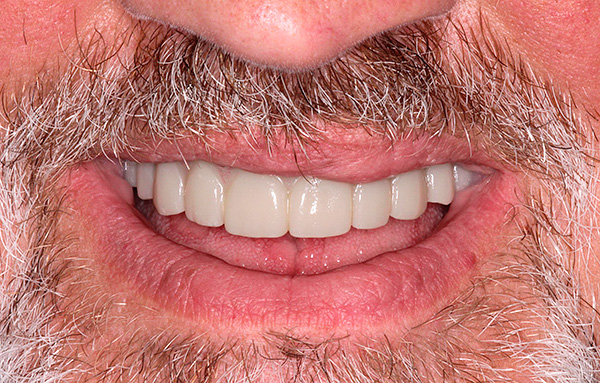
However, the use of each technique is justified for certain conditions of the jawbone: All-on-6 is not necessary to use with a sufficient amount of bone tissue, and All-on-4, on the contrary, is ineffective with low quality bone structure. Therefore, only the attending physician should choose the method of prosthetics according to the results of clinical and computer examination of the oral cavity and jaw bone.
Dentists SMILE-AT-ONCE are members of: Russian Dental Association, Russian Association of Implantologists (RASTI), International Fund for Implantation (IF) and International Organization for Dental Implantology (ITI). They are fluent in both methods and are actively developing an immediate load protocol in Russia, exchanging experience with Russian and foreign colleagues at various symposia and conferences.
If you want to get a detailed answer about the possible use of All-on-4 and All-on-6 technologies in your case, then on Wednesdays and Saturdays there are days of presentation consultations, where any patient who has high-quality computed tomography (from a specialized diagnostic center, for example , "Picasso)" can get a free consultation and participate in the process of 3D-planning options and comparing performance indicators.
Immediate-load dental prosthetics with All-on-6 technology

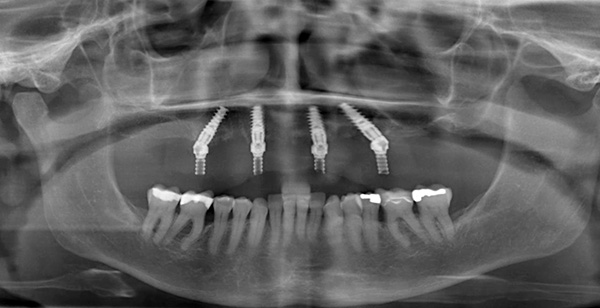
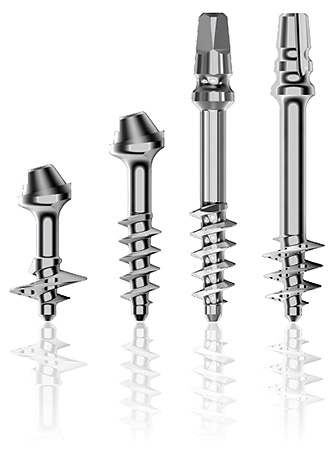
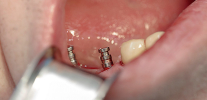
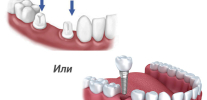
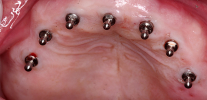
Do I need to remove all the roots of teeth remaining in my mouth before all-on-4 prosthetics? Or is it all inclusive and the doctor himself will remove everything before implantation?
Hello! Using All-on-4 technology according to Nobel's protocol, tooth extraction and implant placement are performed in one surgical procedure. That is, you do not need to remove teeth in advance.